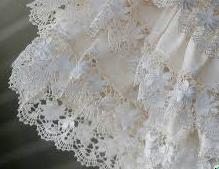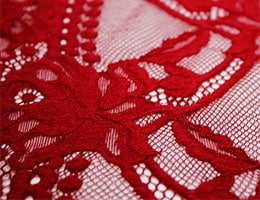 When we use the word lace , we can refer to different issues. One of the most frequent uses of the term refers to the ornamental fabric made with openwork or mesh that is usually decorated with embroidery.
When we use the word lace , we can refer to different issues. One of the most frequent uses of the term refers to the ornamental fabric made with openwork or mesh that is usually decorated with embroidery.
The lace is transparent and has drawings (geometric or otherwise) that are joined together in a network . The fabric named in this way is characterized by fusing compact and open spaces, with a greater or lesser concentration of thread, respectively, which serves to create different motifs or drawings. The main difference between lace and embroidery is that the latter is created on a pre-existing piece of fabric, while the former is used to make the fabric itself.
The production of lace can be carried out using various production techniques , such as braiding, knotting, twisting, interweaving or linking strands of thread. Depending on the technique used, we can differentiate between needle lace , bobbin lace , crochet lace or mechanical lace .
Bobbin lace is made by hand , and requires the following instruments and elements: the template with the desired design (which is usually made of cardboard), pins, bobbins, a pad and strands of plant fiber. The bobbins are small sticks, around whose upper half the thread is wound or wound, since it is the thinnest part, so that it is taut due to the balance with the weight of the other half, whose thickness is greater. Throughout the weaving process, the canvas must be held with pins, which are stuck into the pad, according to the design.
On the other hand , we have needle lace , which is done by hand, with the help of hooks or needles, while recreating the design made on a sheet of paper. To make the work easier, the thread is usually fixed at certain points on the paper. Although this method is more laborious than the first, the results are usually finer.
With the arrival of machines, lace making underwent a significant transformation, which gave rise to the birth of mechanical lace . Today, most lace products are made this way. Although it reduces production costs, it also completely eliminates the typical magic of artisanal work; For this reason, exclusive pieces continue to be made by hand.
Tablecloths, curtains and women's underwear are some of the textile products that feature lace, made with fibers such as linen, silk or cotton .
 In the context of finance, all the assets that banking entities store in the form of money are called reserve requirements. The reserve requirement, therefore, is made up of the deposits that banks maintain as liquid reserves (in cash).
In the context of finance, all the assets that banking entities store in the form of money are called reserve requirements. The reserve requirement, therefore, is made up of the deposits that banks maintain as liquid reserves (in cash).
Also called the reserve coefficient , the reserve requirement cannot be used to grant credits or to make investments. The country's monetary authorities are in charge of setting the minimum coefficient that banks must have as reserve requirements.
Suppose that, in a certain nation where the currency is the peso , a reserve coefficient of 3% is established. This means that banks , for every 100 pesos they receive as a deposit, have to keep 3 pesos as reserve. The remaining 97 pesos can be lent or invested.
Fitting, on the other hand, is the act and result of fitting something (adjusting or tucking it in). For example : “I don't know how I'm going to fit the new piece of furniture into the living room wall” , “You need to use grease to make that piece fit in the opening” .
